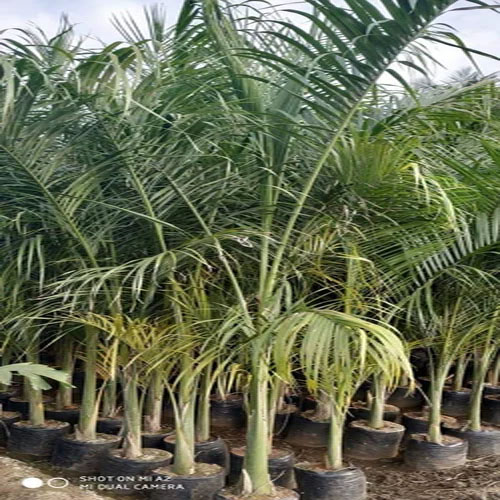Bottle Palm ( Royal Palm) Plants
Bottle Palm (Hyophorbe lagenicaulis) and Royal Palm (Roystonea species) are two distinct types of palms, each with unique characteristics and uses. Here’s a detailed overview of both:
Bottle Palm (Hyophorbe lagenicaulis)
Features:
-
Foliage:
- Color: Green, feathery fronds.
- Shape: Pinnate leaves with a graceful arching form.
-
Growth Habit:
- Form: Known for its distinct bottle-shaped trunk, which is swollen at the base and tapers towards the top.
- Height: Typically grows to about 10-15 feet tall. It has a relatively slow growth rate compared to other palms.
-
Flowers and Fruit:
- Flowers: Small, inconspicuous flowers.
- Fruit: Produces small, round fruits that turn from green to black as they ripen.
-
Care and Cultivation:
- Sunlight: Prefers full sun but can tolerate partial shade.
- Soil: Thrives in well-draining, sandy or loamy soil. It prefers slightly acidic to neutral pH.
- Watering: Requires regular watering, particularly during dry periods, but avoid waterlogging.
- Fertilizing: Use a balanced, slow-release fertilizer during the growing season.
-
Uses:
- Ornamental: Popular in tropical and subtropical gardens for its unique trunk shape and compact size.
- Landscaping: Ideal for small gardens, patios, or containers.
Royal Palm (Roystonea species)
Features:
-
Foliage:
- Color: Green, feather-like fronds.
- Shape: Pinnate leaves that are large and arching.
-
Growth Habit:
- Form: Tall and stately with a single, smooth trunk. The trunk is typically gray or white.
- Height: Royal Palms can reach heights of 40-70 feet, depending on the species and growing conditions.
-
Flowers and Fruit:
- Flowers: Small, creamy white flowers arranged in large clusters.
- Fruit: Produces small, round fruits that turn from green to black.
-
Care and Cultivation:
- Sunlight: Prefers full sun and performs best in bright, sunny locations.
- Soil: Thrives in well-draining, fertile soil. Tolerates a range of soil types but prefers slightly acidic to neutral pH.
- Watering: Regular watering is important, especially during dry periods, but avoid waterlogging.
- Fertilizing: Regular feeding with a balanced palm fertilizer helps promote healthy growth.
-
Uses:
- Ornamental: Widely used in tropical and subtropical landscapes for its majestic appearance and striking form.
- Landscaping: Ideal for large gardens, avenues, and as a focal point in outdoor spaces.
Summary
- Bottle Palm (Hyophorbe lagenicaulis) is a compact, slow-growing palm known for its unique bottle-shaped trunk and is suitable for smaller spaces.
- Royal Palm (Roystonea species) is a tall, elegant palm commonly used in large-scale landscaping and is valued for its classic, stately appearance.
If you have specific questions or need further details about either the Bottle Palm or Royal Palm, feel free to ask!


